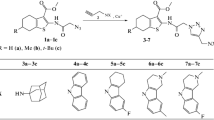Abstract
In cultured cerebellar granule cells, we examined the effects of dihydropyridines (DHPs) on K+ currents, using the whole-cell recording configuration of the patch-clamp technique and on Ca2+-activated K+ channels (“maxi K+ channels”) using outside-out patches. We found that micromolar concentrations of nicardipine, nifedipine, (+) and (−) BAY K 8644, nitrendipine, nisoldipine and (−) nimodipine block 10–60% of macroscopic K+ currents. The most potent of these DHPs was nicardipine and the least potent, (−) BAY K 8644. (+) Nimodipine had no effect on this current. The inhibitory effects of nifedipine and nicardipine were not additive with those of 1 mM tetraethylammonium (TEA). Outside-out recordings of “maxi K+ channels” showed a main conductance of 200 pS (in 77% of the patches) and two subconductance states (in 23% of the patches). Neither nifedipine nor nicardipine affected the main conductance, but decreased the values of the subconductance levels. In 10% of these patches, nicardipine induced a flickering activity of the channel. These findings show that both Ca2+ and K+ channels have DHP-sensitive sites, suggesting similarity in electrostatic binding properties of these channels. Furthermore, cerebellar granule cells may express different subtypes of “maxi K+ channels” having different sensitivities to DHPs. These drugs may provide new tools for the molecular study of K+ channels.
Similar content being viewed by others
References
Barrett JN, Magleby KL, Pallotta BS (1982) Properties of single calcium-activated potassium channels in cultured rat muscle. J Physiol (Lond) 331:211–230
Blatz AL, Magleby KL (1987) Calcium-activated potassium channels. Trends Neurosci 10:463–467
Butler A, Tsunoda S, McCobb DP, Wei A, Salkoff L (1993) mSlo, a complex mouse gene encoding “maxi” calcium-activated potassium channels. Science 261:221–224
Catterall WA, Striessnig J (1992) Receptor sites for Ca2+ channel antagonists. Trends Pharmacol Sci 13:256–262
Cull-Candy SG, Marshall CG, Ogden D (1989) Voltage-activated membrane currents in rat cerebellar granule neurones. J Physiol (Lond) 414:179–199
Egan TM, Dagan D, Levitan IB (1993) Properties and modulation of a calcium-activated potassium channel in rat olfactory bulb neurons. J Neurophysiol 69:1433–1442
Ellory JC, Kirk K, Culliford SJ, Nash GB, Stuart J (1992) Nitrendipine is a potent inhibitor of the Ca2+-activated K+ channel of human erythrocytes. FEBS Lett 296:219–221
Fagni L, Bossu JL, Bockaert J (1991) Activation of a large-conductance Ca2+-dependent K+ channel by stimulation of glutamate phosphoinositide-coupled receptors in cultured cerebellar granule cells. Eur J Neurosci 3:778–789
Fukushima Y (1982) Blocking kinetics of the anomalous potassium rectifyer of tunicate egg studied by single channel recording. J Physiol (Lond) 331:311–331
Hermann A, Gorman ALF (1981) Effects of 4-aminopyridine on potassium currents in a molluscan neurone. J Gen Physiol 78:63–86
Hume JR (1985) Comparative interactions of organic Ca2+ channel antagonists with myocardial Ca2+ and K+ channels. J Pharmacol Exp Ther 234:134–140
Ikemoto Y, Ono K, Yoshida A, Akaike N (1989) Delayed activation of large-conductance Ca2+-activated K+ channels in hippocampal neurons of the rat. Biophys J 56:207–212
Kass RS, Tsien RW (1975) Multiple effects of calcium antagonists on plateau currents on cardiac Purkinje fibers. J Gen Physiol 66:169–192
Kume H, Graziano MP, Kotlikoff MI (1992) Stimulatory and inhibitory regulation of calcium-activated potassium channels by guanine nucleotide-binding proteins.
Latorre R, Miller C (1983) Conduction and selectivity in potassium channels. J Membr Biol 71:11–30
Lucchesi KJ, Moczydlowski E (1991) On the interaction of bovine pancreatic trypsin inhibitor with maxi Ca2+-activated K+ channel. J Gen Physiol 97:1295–1319
Moczydlowski E, Latorre R (1983) Gating kinetics of Ca2+-activated K+ channels from rat muscle incorporated into planar bilayers. Evidence for two voltage-dependent Ca2+ binding reactions. J Gen Physiol 82:511–542
Moyer JR, Thompson JLT, Black JP, Disterhoft JF (1992) Nimodipine increases excitability of rabbit CA1 pyramidal neurons in an age- and concentration-dependent manner. J Neurophysiol 68:2100–2109
Nerbornne JM, Gurney AM (1987) Blockade of Ca2+ and K+ currents in bag cell neurons of Aplysia California by dihydropyridine Ca2+ antagonists. J Neurosci 7:882–893
Nowak L, Bregetovski P, Ascher P, Herbert A, Prochiantz A (1984) Magnesium gates glutamate-activated channels in mouse central neurons. Nature 307:462–465
Reinhart PH, Chung S, Martin B, Brautignan DL, Levitan IB (1991) Modulation of calcium-activated potassium channels from rat brain by protein kinase A and phosphatase 2A. J Neurosci 11:1627–1635
Richard S, Charnet P, Ouadid H, Tihao F, Nargeot J (1988) Effects of the Ca-antagonist nicardipine on K+ currents and Na+-Ca2+ exchange in frog atrial fibers. J Mol Cell Cardiol 20:1133–1140
Richards NW, Lowy RJ, Ernst SA, Dawson DC (1989) Two K+ channel types, muscarinic agonist-activated and inwardly rectifying in a Cl− secretory epithelium: the avian salt gland. J Gen Physiol 93:1171–1194
Stanfield PR (1983) Tetraethylammonium ions and the potassium permeability of excitable cells. Biochem Pharmacol 97:1–66
Stockgbridge LL, French AS (1989) Characterization of a calcium-activated potassium channel in human fibroblasts. Can J Physiol Pharmacol 67:1300–1307
Thompson SH (1977) Three pharmacologically distinct potassium channels in molluscan neurones. J Physiol (Lond) 265:465–488
Treherne JM, Ashford MLJ (1991) Calcium-activated potassium channels in rat dissociated ventromedial hypothalamic neurons. J Neuroendocrinol 3:323–329
Valmier J, Richard S, Devic E, Nargeot J, Simonneau M, Baldy-Moulinier M (1991) Dihydropyridines interact with calcium-independent potassium currents in embryonic mammalian sensory neurons. Pflügers Arch 419:281–287
Van-Vliet BJ, Sebben M, Dumuis A, Gabrion J, Bockaert J, Pin JP (1989) Endogenous amino acid release from cultured cerebellar neuronal cells: effect of tetanus toxin on glutamate release. J Neurochem 52:1229–1239
Weik R, Lönnendoker U, Neumcke B (1989) Low-conductance states of K+ channels in adult mouse skeletal muscle. Biochim Biophys Acta 983:127–134
White RE, Schonbrunn A, Armstrong DA (1991) Somatostatin stimulates Ca2+-activated K+ channels through protein dephosphorylation. Nature 351:570–573
Author information
Authors and Affiliations
Rights and permissions
About this article
Cite this article
Fagni, L., Bossu, J.L. & Bockaert, J. Inhibitory effects of dihydropyridines on macroscopic K+ currents and on the large-conductance Ca2+-activated K+ channel in cultured cerebellar granule cells. Pflugers Arch. 429, 176–182 (1994). https://doi.org/10.1007/BF00374310
Received:
Revised:
Accepted:
Issue Date:
DOI: https://doi.org/10.1007/BF00374310



